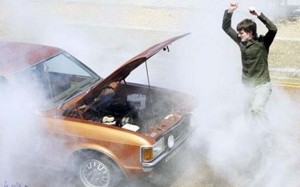May is National Youth Traffic Safety Month, and among the many story ideas we’ve received to mark the occasion is one that offers a few tips for teens on how to handle a breakdown. Spending a weekend driving through metro Los Angeles we realized the recommendations probably would help many adults, as well, several folks we saw taking unnecessary risks while waiting for help after a breakdown.
The good news is that today’s cars are more reliable than ever. Compared to even a decade ago you’re likely to see far fewer vehicles stuck on the shoulder, whether from an overheated radiator, a flat tire or some other setback. But breakdowns still occur and perhaps because they have become less common motorists often don’t know what to do, however much experience they’ve had behind the wheel.
“According to parents, a majority of teen drivers(2) are relatively ‘clueless’ about general auto repair and vehicle maintenance, including the simple task of filling the gas tank,” says Brian Hafer, vice president of marketing for maintenance website AutoMD.com.
Knowing how to handle a breakdown, however, can be a matter of life and death in the worst situations.
The first rule is to get your car off the road, if at all possible. Stopping in traffic increases the risk that you are going to be struck by another vehicle. And once you’re out of the way, recommends Hafer, turn your steering wheel away from traffic so that if the vehicle does inadvertently begin to move it won’t roll back into traffic.
One of the most frequent mistakes drivers make after a stall or breakdown is to not activate their flashers. Whether you’ve had a collision or mechanical failure your vehicle’s warning signals suddenly become one of the most important safety devices at your disposal. Many savvy drivers also keep an emergency kit in the trunk that includes either flares or reflectors. It’s a requirement in many countries, especially in Western Europe and can help warn away oncoming traffic at a great distance.
But don’t exit your vehicle if that means risking stepping out into traffic. About 4,000 pedestrians were killed in the U.S. last year, more than 10% of total roadway fatalities, and 300 of them died while changing a tire or otherwise working on a stalled or broken down vehicle.
Experts, including AutoMD, in fact, recommend you stay inside your vehicle unless it is absolutely unsafe to do so – such as after a breakdown that might have left you in a traffic lane with disabled flashers. So, stay in the vehicle with your doors locked and your seatbelt fastened. Just because your car isn’t moving doesn’t mean you won’t be tossed about should a passing vehicle hit yours.
Most folks these days travel with a cellphone – especially younger motorists. Use it to immediately call for help. Many new vehicles these days come with roadside service plans. Most insurance companies offer such services at a small annual fee.
There are many good Samaritans on the road – but also some folks looking to take advantage of a bad situation. Should another driver pull up and offer help do not unlock your doors or step outside. Roll your window down just enough to talk to them. Advise them you have called for help or, if need be, ask them to make the call for you.
If you do have an incident you can readily resolve, most likely in the form of a flat tire, make sure your vehicle is pulled onto a flat area as far away from traffic as possible. Follow the instructions in your owner’s manual for the safe you of the jack and other tools. Again, make sure you have your flashers on and, if possible, call for help.
A few precautions can keep the inconvenience of a breakdown from becoming a crisis.

